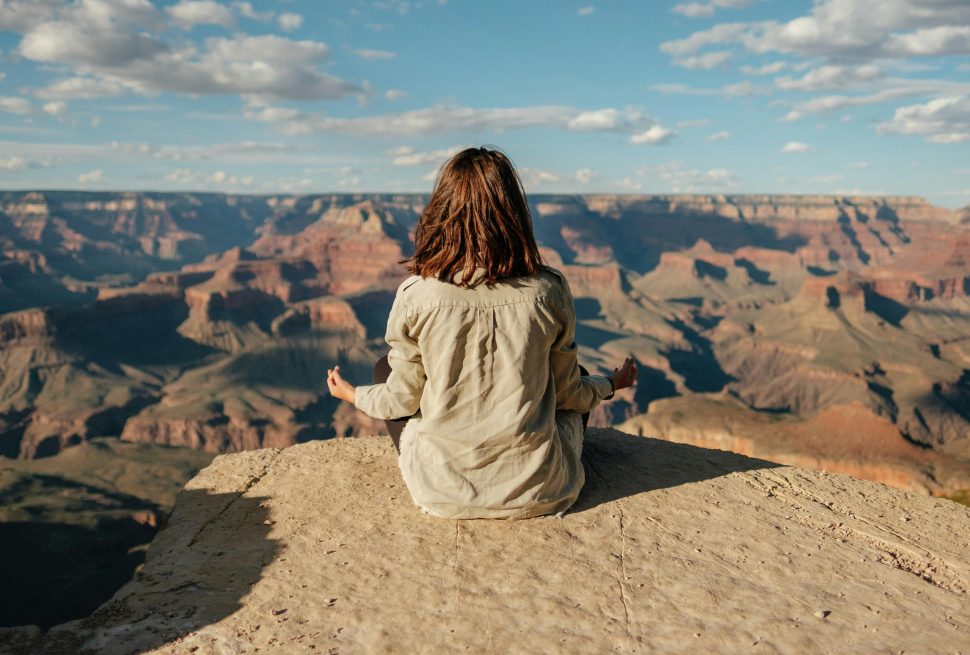Generally, when we say ‘meditation’ we perceive it as a practice of directing focus to a focal point to attain self-awareness or simply a practice of mindfulness. But meditation is not exactly that. The literal translation of meditation would be dhyana but the above definition does not define dhyana. It rather defines dharana. In order to understand dharana and dhyana we need to understand ashtanga yoga. It is basically the ashta anga(8 limbs) of yoga. They are:
- Yama
- Niyama
- Asana
- Pranayama
- Pratyahara
- Dharana
- Dhyana
- Samadhi
1. Yama: (Principles or moral code)
- Ahimsa – A principle of non-violence
- Satya – A principle of Truthfulness
- Asteya – A principle of non-stealing
- Brahmacharya – Continence / Celibacy
- Aparigah – A principle of non-hoarding or non-possessiveness
2. Niyama: (Personal Disciplines)
- Saucha- Cleanliness of body and mind
- Santosha- Contentment
- Tapas- Discipline
- Svadhyaya- Self-study
- Ishvara Pranidhana- Surrender to the Divine
3. Asana: (Yoga Positions or Yogic Postures)
The word literally translates to “seat”. These are meditative postures that promote stillness of mind, and physical postures that facilitate sitting for long periods of time in those meditative postures.
4. Pranayama: (Yogic Breathing)
Prana means life force. Breathing techniques that promote our life force are pranayamas. Rishi Patanjali says retention and splitting of breath in a special way and changing the rhythm of the breath, is pranayama. When we break the movement of the breath by consciously breathing long breaths with counts while paying attention to different parts of the body, it clears impurities from the mind.
5. Pratyahara: (Withdrawal of Senses)
This is a state when the senses don’t engage with the external environment instead turning inwards towards the consciousness. In this state, it is easier to control the senses. We have five sheaths or layers, Pancha Kosha, that envelops the inner Atman or consciousness:
- Annamaya Kosha – the food sheath
- Pranayama Kosha – the breath sheath
- Manomaya Kosha – the mind sheath
- Vijnyanmaya Kosha – the intellect sheath
- Anandamaya Kosha – the bliss sheath
6. Dharana: (Concentration on Object)
This refers to paying attention to one particular thing, idea, or place and fixing it there. Sometimes, people use a mantra or the breath to do this. When you fix your mind on a specific point, over time, your mind stops wavering; you become free from conflict; it is a unique time when your thoughts and actions are in congruence. So, you slowly and steadily still yourself and calm down as you merge with the moment. As you become one with the moment, you can effortlessly enter meditation or dhyana.
7. Dhyana: (Meditative absorption)
The seventh limb is ‘meditative absorption’ – when we become completely absorbed in the focus of our meditation, and this is when we’re really meditating. All the things we may learn in class, online, or from a teacher are merely techniques offered to each person in order to help them settle, focus, and concentrate, the actual practice of meditation is definitely not something can actively ‘do’, rather it describes the spontaneous action of something that happens as a result of everything else.
History of meditation
Meditation, an ancient practice rooted in the wisdom of the Vedas and Upanishads, traces its origins back through the annals of time. The revered Sage Patanjali expounded on this transformative practice in his seminal work, the Patanjali Yoga Sutras, detailing the eight limbs of yoga. The essence of meditation, as elucidated in these texts, transcends the ages, carrying the profound intention of attaining samadhi and moksha.
Meditation, a time-honored tradition, finds its roots in the ancient scriptures known as the Vedas and Upanishads. The venerable Sage Patanjali, in his monumental work, the Patanjali Yoga Sutras, intricately weaves the tapestry of meditation into the eight limbs of yoga. This sacred practice, with its origins deeply embedded in these timeless texts, is imbued with the noble goal of achieving samadhi and moksha.
The practice of meditation has an enduring legacy, its threads intricately woven into the fabric of ancient wisdom found in the Vedas and Upanishads. Sage Patanjali, in his profound exploration of yogic philosophy within the Patanjali Yoga Sutras, sheds light on the eight limbs of yoga, with meditation standing as a central pillar. The purpose behind this age-old practice remains rooted in the pursuit of samadhi and moksha.
Delving into the rich tapestry of ancient wisdom, meditation emerges as a practice deeply enshrined in the Vedas and Upanishads. Sage Patanjali’s Patanjali Yoga Sutras serve as a guide, unfolding the intricate art of meditation within the eight limbs of yoga. This enduring tradition, with its origins in these sacred texts, unfolds with the noble intent of attaining samadhi and moksha.
Benefits and Purpose of Meditation:
Embarking on the journey of meditation opens the door to profound self-discovery and inner tranquility. If you’re wondering, “How to meditate?” the process begins with finding a quiet space, assuming a comfortable posture, and focusing on your breath or a chosen point of attention. As you delve into the practice, allow thoughts to come and go without judgment, fostering a gentle return to your focal point. This simple yet powerful technique, when incorporated into your daily routine, can lead to a myriad of benefits. From reduced stress and enhanced emotional well-being to improved concentration and a heightened sense of awareness, the art of meditation holds transformative potential.
Physical aspect: Our day-to-day chaotic lifestyle impacts the functioning of our body due to the accumulation of stress. This kind of stress is called cumulative stress. There are areas in our body that store stress. The main stress points According to Ilijic, there are five main areas that store stress: the jaw/neck/face, shoulders/heart, diaphragm/lungs, stomach/gut, and pelvic floor/hips. “According to yin yoga, energy is held in all parts of our tissues and joints”. So, if we heal mentally, many of our physical issues will fade away.
Mental aspect: Meditation is proven to help with better focus, stability, cognitive function, patience, creativity, imagination, and many more. It also helps in releasing stress and helps with the illness such as anxiety, depression, ADHD, OCD, insomnia, etc. Meditation helps to attain a state of mental equilibrium and equipoise. It increases happiness and optimism. It helps to reduce impulsivity, cravings, and addictions.
Spiritual aspect: Meditation is the means to attain samadhi and moksha. Meditation is the way to connect aatma with Paramatma. It is the means to gain the divine ecstasy; divine satisfaction. It is the way to be free from sorrows and afflictions that keep us in distance from our purpose. It is a doorway to the ultimate peace.
In a nutshell, meditation is not what we do but something that happens after attaining integrated focus and self-awareness; which of course needs years of practice, persistence, and dedication. It is a beneficial practice done to get rid of stress, imbalance, and dissatisfaction, enhancing self-awareness, stability, and peace in one’s life.




